Mitsuba (三つ葉) is known by a few names and the most common would be Japanese parsley. It’s quite similar to parsley in size and appearance. Other names are wild parsley or Japanese hornwort.
The name
三つ葉 or Mitsu-ba literally means three objects + leaves (three leaves) or compound leaves with three leaflets. It is often spelt using Katakana in nurseries in Japan. The genus is Cryptotaenia and the species is Japonica. It’s a perennial and part of the celery family. I’ve had some plants live a couple years, but they do generally all dry up here in Australia due to the heat. But with a little care, you can keep it alive. Of course as they get older, their bitterness increases.
Varieties of mitsuba
There’s a white and and green variety in Japan but I’ve been used to the white variety from the Kansai region.
Growing locations and season
In Japan mistuba is grown in Shizuoka, Osaka and the east coast around Ibaraki, Chiba, Saitama and Aichi. It’s mainly grown hydroponically (green mitsuba) and harvested about 8 times over the year. There are cut leaf farms and also those that leave the root on the plant when presenting for sale. Peak demand in Japan is in December as it’s used for the new year celebrations.
Seed will sprout here in Western Australia in April and plants are pretty much full size in May. It will grow to almost a meter or 3′ if you give it ideal conditions. In the northern hemisphere at home, it flowers in June-August. You can treat it similarly to parsley, let it go to seed and spread and you’ll have it popping up in the garden each year and staying for another season or so if it’s comfy.
The taste
It’s so unique and I love the tang. It’s got a lovely taste a little like coriander but not as powerful. It’s light, refreshing and can be slightly bitter depending on how it’s collected and prepared. The stems are used in soups in Japan and I love the contrast of the soft crunch of those against the kameboko and steamed vegetables often served with it.
It reminds me of Kyoto, cold winter nights and celebration, but with a subtle refined taste. It’s generally presented in such a minimalist way, so the flavour of the stem or leaves stand on their own. I have some memories of it being used in osumashi with tornado cooked egg or in donburi, that’s not a bad combination either.
Health benefits
The leaves have high levels of calcium, iron, potassium, beta-carotene and vitamin A and C.
Mitsuba’s scent
The scent of the plant contains cryptone (compound also found in eucalyptus and mint) and monoterpene which is said to increase appetite, assist with digestion, relaxation and promoting sleep. It contains other essential oils and monoterpenes such as α-pinene, sabinene, and β-pinene.
Possibly why this is served in osumashi at the beginning of traditional Japanese meals.
It’s beauty
I love seeing it pop up in the garden each year (see above, it’s hot here so they die off). The little sprouts come through and I get excited and give them extra care as I weed in between them. I move some to pots to ensure I have a safe supply. Sometimes they’ll get decimated by cabbage white butterfly caterpillars or snails.
They’re a hardy thing once established and love the water. They have pretty leaves, grow to a manageable size and the flowers are super cute.
It’s just one of those perennials that I allow to go free. It doesn’t take over the garden and it’s so useful in cooking. Plus it’s so easy to manage or just pull out.
The flowers
it has these delicate white flowers that bloom from the schizocarp fruits. They’re super cute as they start off tiny and bloom into basil-like flowers.
Gathering your mitsuba seed
Once the seed has dried on the stalks, I cut the dried stalks off carefully with scissors and run my fingers down it to strip it of seeds and put them into a paper bag for storage. You don’t get too much extra plant material, it’s mainly seed by the time it’s dried.
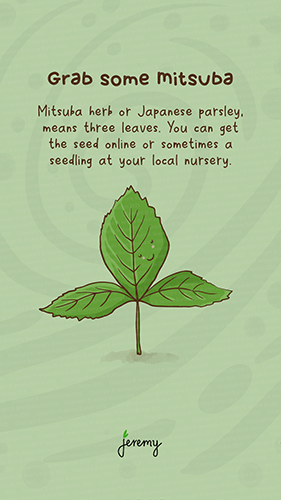
Plant your seed
Plant it into a pot, it doesn’t have to be big to start off. A small 0.5L or 17oz pot is enough to get it started.
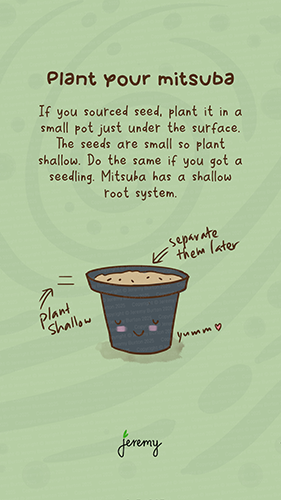
Sunshine and climate
Mistuba likes full sun at times and if it’s really hot, part shade is and a cool, temperate climate. If you give it full sun, you might get the strong bitterness in the leaves.
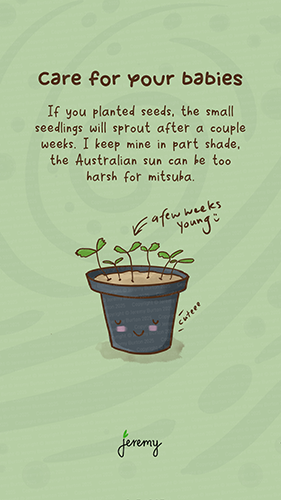
Picking your mitsuba
Harvest the leaves, stalks or root depending on how you want to prepare it. I use the stalks and younger leaves in osumashi. Like parsley, you can just break stalks or leaves off and it will keep producing.
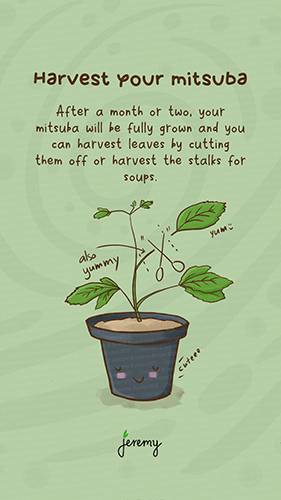
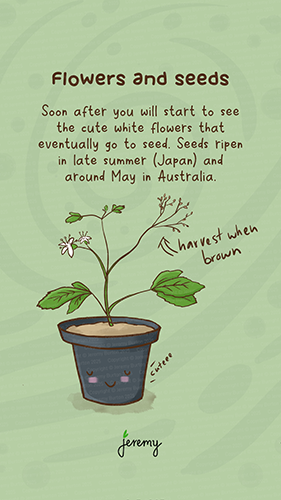
Eat your mitsuba
I had mitsuba often in Kyoto as they blanch the white stalks and add them with small leaves to a clear osumashi soup. I LOVE it and it’s the main reason I sourced seed to get it into the garden. Osuimono (お吸い物) translates to water thing and osumashi is a kind of osuimono. Osumashi generally has a simpler flavour and set of ingredients. Another fave was Japanese clear clam soup (あさりの潮汁), but we’ll talk about that in another blog.
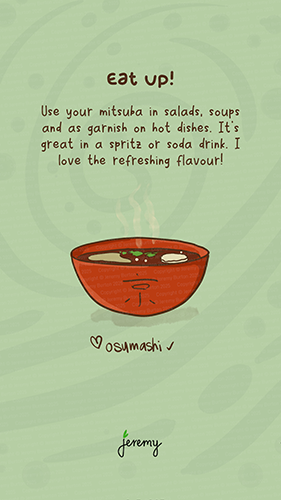
Keeping it alive for next season
Take a cutting and root it in water inside the house. Keep it warm and regrow it like you might for basil. Or, another method is to germinate the seed inside on a silicone mat or in a small pot. It will grow during colder months if you provide warmth, like in the greenhouse.
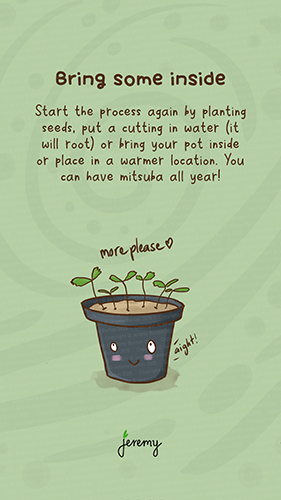
You’ll have mitsuba all year round! Leave a comment if you found this useful!
Join me on Threads for more or subscribe at the bottom of the page for these posts in your email.

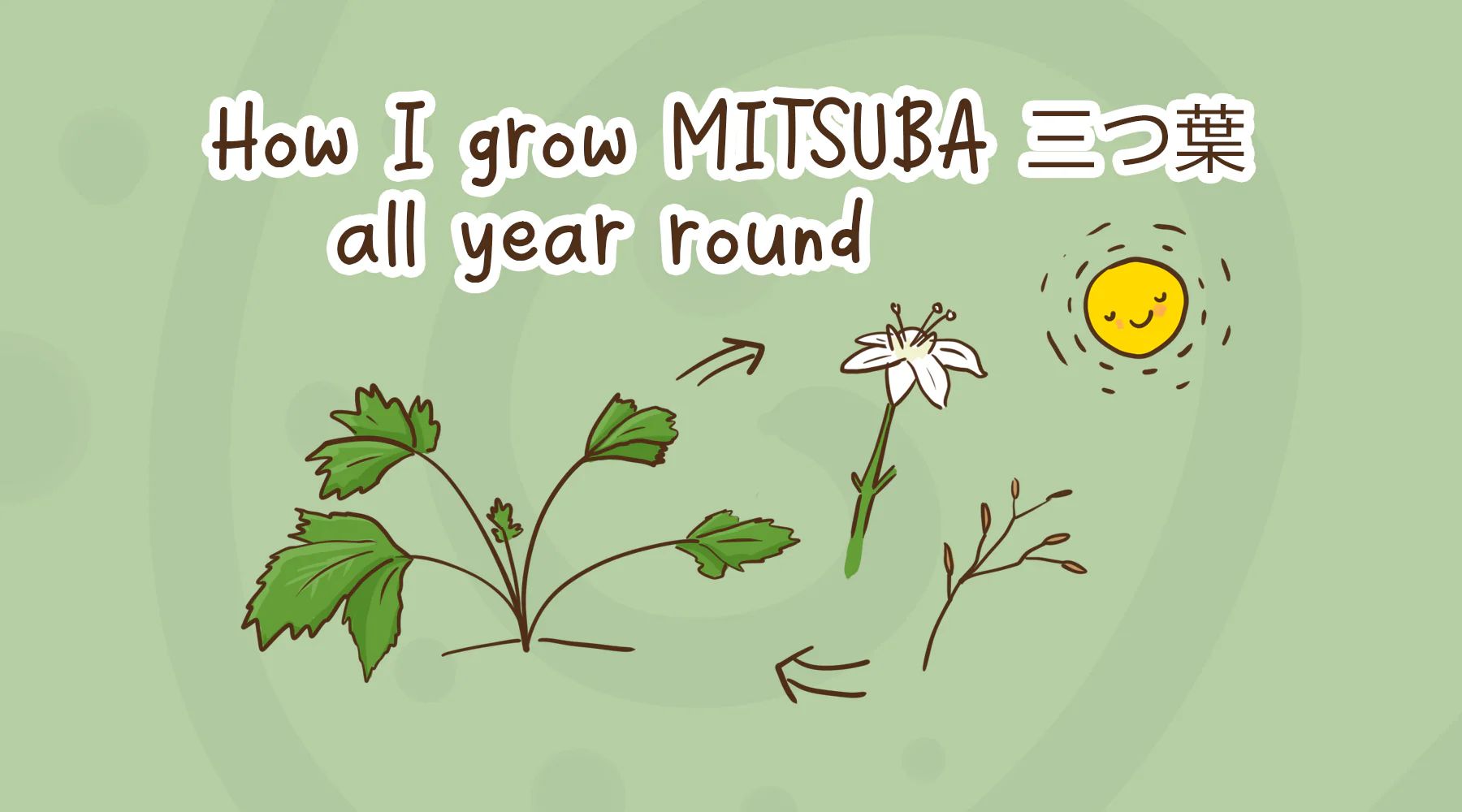



Leave a Reply
You must be logged in to post a comment.